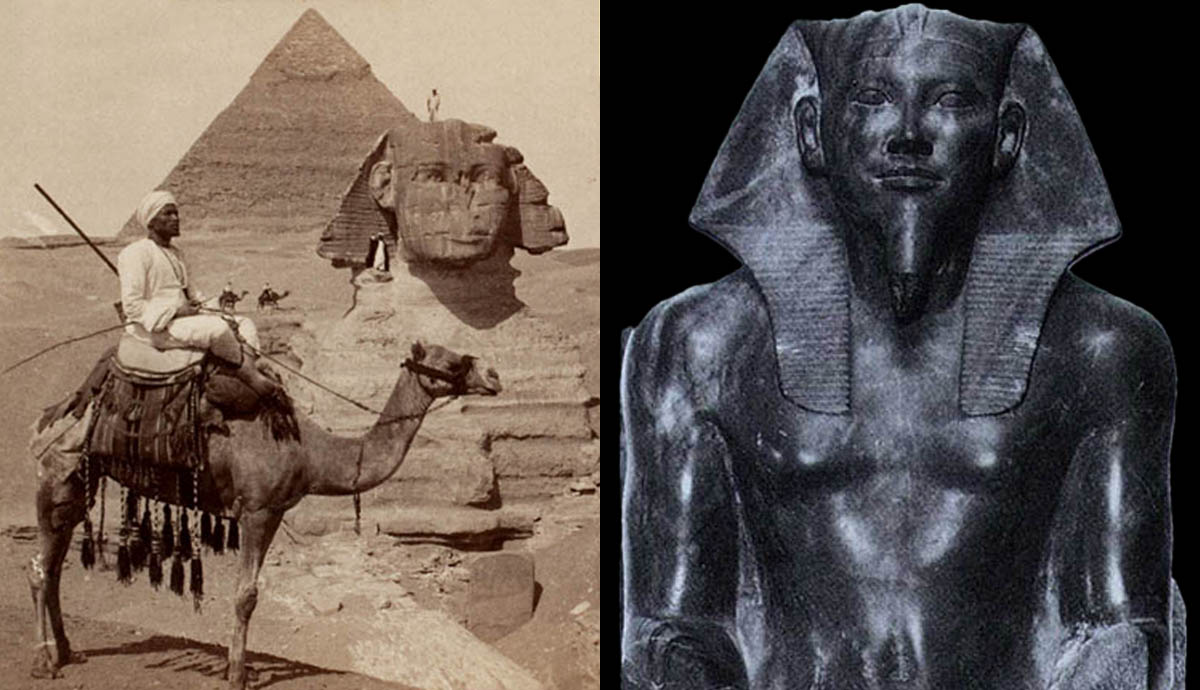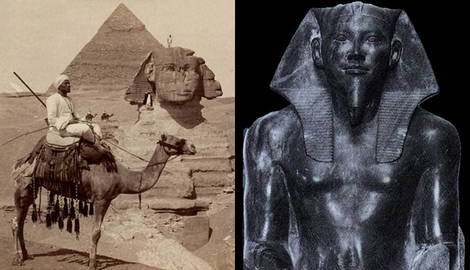
Once thought to be the largest of the three Giza pyramids, now we know it is slightly shorter than the pyramid of Khafre’s father, Khufu. It is perhaps the best researched by Egyptologists, and most of what we know about Egyptian pyramids is due to the study of Khafre’s pyramid. For instance, it still bears, at its top, the residues of the original limestone casing. Let’s explore the history of Egypt’s most extensively researched pyramid.
The Pyramid of Khafre

Pharaoh Khafre was the one who ordered the construction of the second largest pyramid ever built by human beings. It was also arguably the finest example of ancient Egyptian engineering, as it is today one of the best-preserved, along with the buildings comprising the pyramid complex of Khafre. It was built around 2,570 BCE, during the 4th dynasty, on the Giza plateau where Khafre’s father had built his pyramid before him. Although it did not reach the height of his father’s pyramid, Khafre’s was steeper, towering over the Egyptian Western Desert at an angle of 53° 13’.
As mentioned earlier, the pyramid of Khafre is the centerpiece of a vast compound, boasting one of the best preserved Valley Temples in all of Egypt, and of course, the well-known Great Sphinx. Remains of a satellite pyramid, perhaps for one of his wives, have been found to the south of the main pyramid, and there was originally a mortuary temple to the east, connected by means of a long causeway to the Valley Temple, the Sphinx and the harbors where ships docked during festivities.
The pharaoh’s body was never found. The granite sarcophagus found inside the main chamber is considerably less detailed in its manufacture than similar sarcophagi from the same period. It was built out of a solid slab of granite, with a granite lid, and a number of safety measures had been built on the artifact to ensure it was not opened for all eternity. However, when explorers penetrated the chamber in the 19th century, they found the sarcophagus open and the lid intact, on the floor near the coffer. This has led some Egyptologists to think it never hosted the body of the pharaoh himself, although the reasons for this remain obscure.
Who Was Pharaoh Khafre?

King Khafre ruled Egypt as a god on earth for about a quarter of a century, around 2,570 BCE. He was the son of Khufu, and he succeeded his father to the throne of Egypt. He was in time succeeded by his son, Menkaure, builder of the third and smallest of the Great Egyptian Pyramids at Giza. As was common at the time, he may have had several wives. This is supported by the fact that at least 12 sons and 4 daughters of the king have been attested in textual and archaeological sources.
The inconsistencies surrounding the dates and duration of his reign stem from the fact that ancient Egyptians never spoke about the deaths of their rulers. Death among kings and queens was a taboo subject, thus most dates need to be inferred from sources that refer to other topics. For instance, a duration of 24 or 26 years for the reign of Khafre has been proposed on account of a carved source on a mastaba that mentions 13 cattle countings happening during the reign of Khafre. As the cattle count was an event held biannually, it is surmised that he ruled at least 24 years (if the first count happened during his very first year).

Not much is known of Khafre by Egyptian contemporary sources, which are scarce. The Greeks, however, wrote detailed accounts of his personality and deeds. The writings of Manetho, Herodotus, and Diodorus among others, should not be taken too seriously, for they were written more than two millennia after the pyramid of Khafre was built, and they reconstructed their accounts solely on hearsay. The Greeks called the king Khephren, or Chephren, and depicted him as a cruel tyrant, just like his father. On the other hand, Menkaure (Mykerinos in Greek) could have been a benevolent leader, deeply ashamed by his antecessors’ behavior, intent on compensating the Egyptian people for the pain Khufu and Khafre had put them through.
The Egyptian Pyramids: A History of Tomb Robbing

The pyramid of Khafre had a very visible entrance on one of the sides, almost 40 ft. above ground, and a less visible one beginning at ground level. This arrangement tempted many people over the years to gain access to its interior. Tomb robbings, including the looting of Egyptian pyramids, were a common occurrence in Dynastic times. The pyramid of Khafre was probably first opened and robbed during the First Intermediate Period. During the New Kingdom, Ramesses II usurped some of the buildings at Giza, and is said to have taken limestone blocks from the pyramid of Khafre in order to build a temple at Heliopolis.
Medieval records such as the History of Ibn Abd as-Salaam note that the pyramid of Khafre was opened in the year 774 after the Hegira, 1372 CE. Other sources claim that part of the pyramid’s casing was removed shortly before that time, and used in the construction of the mosque of al-Hassan.
In 1646, a British scientist named John Greaves visited the pyramids, noting that a considerable part of the limestone casing was still in place and that its surface was smoother than that of Khufu’s pyramid. On the 2nd March, 1818, the explorer and strongman Giovanni Battista Belzoni who had found the original north side entrance to the pyramid, reached the King’s Chamber, only to find it empty save the black granite sarcophagus and the intact lid on the floor. He then left a conspicuous inscription on the wall, which can still be seen today.
The Pyramid of Khafre and Its Temple Complex

While impressive on the outside, the pyramid of Khafre has one of the simplest internal designs. Two entrances lead to two main corridors, one of them carved entirely on the bedrock, which in turn lead to a vestibule and a few rooms before the King’s Chamber. The pyramid itself consists of a core of limestone and casing of granite. The floor on the inside was made of alabaster. Both entrances lead to a narrow passage, which runs in a north/south orientation. The reason behind there being two different entrances is a miscalculation, which meant that the first passage to be carved was off to the east, and it was simpler to just make a new one directly into the King’s Chamber, instead of trying to correct the first one. This passage would be used to drag funerary furniture in and out of the pyramid, so it needed to be a straight line.
The Valley Temple, on the other hand, is quite complex, with an array of several corridors, columned halls, storage rooms, and stairs. The most impressive feature at the time it was built should have been the courtyard. Within this courtyard that there was a colonnade supported by rectangular pillars. Each of which also functioned as back support for large statues of the king. In the western wall of the courtyard a series of niches were built in order for statues to be placed.
Within the Khafre pyramid complex, 5 boat pits have been found. However, no boats have been found inside. Finally, the Mortuary Temple shows all the main features that are easily recognizable in similar temples from the Old Kingdom: the entrance hall, the statue niches, several store-rooms, a sanctuary, and the open court.
The Enigmatic Sphinx

The local people called the Sphinx Abu al-Hawal, literally “The Father of Terror”. For centuries, only the monstrous head surfaced from the sand of the desert, and travelers from all time periods found it haunting. In the 19th century, excavations uncovered the entire body, showing that it was an enormous monolith carved directly from the bedrock of the Giza plateau, depicting a lying lion with an anthropomorphic head wearing a nemes wig.
While at first, archaeologists thought of this statue as separate from the Egyptian pyramids, scientific dating has shown that it was created around 2,500 BCE, the same time when Khafre ruled Egypt. It is thought now that the face of the Sphinx was made to resemble Khafre himself, and further excavations have found the causeway that connected the Sphinx to the pyramid of Khafre and its Temple Valley. Stones cut from around the body of the Sphinx were used for a construction directly in front of it, probably a temple or enclosure that was never completed.
Close, But No Cigar

As the title of this article reminds us, appearances often deceive. And for a long time, it was thought that the pyramid of Khafre was the tallest of the three main Giza Pyramids. It certainly was intended that way by its builders, who chose to set it on a bedrock 10 m (30 ft.) higher than that of Khufu’s pyramid. It was a masterful architectural decision, as the ground, albeit uneven, would allow for a higher altitude with fewer stone blocks. As most blocks exceeded the weight of 2 tons and needed to be dragged from the quarries at the great expense of the workforce, this was a sound choice. The best proof of this is the extent to which the builders managed to fool even modern scientists.
The first explorers and Egyptologists determined that the pyramid of Khafre was the tallest of the Egyptian pyramids at Giza. Only very recently, precise measurements have determined that not only it is slightly shorter than Khufu’s pyramid today, it was also shorter originally with a calculated height of 143.5 m (471 ft.) against the 146.6 m (481 ft.) of Khufu’s pyramid. While the latter has deteriorated more over the years, and now stands at a height of 138.5 m (454 ft.), the pyramid of Khafre is still shorter by a few feet and has been measured at 136.4 m (448 ft.) of height from the ground. One unintended factor that still makes it more impressive to the eye than the Great Pyramid of Giza is that most photographs are taken with a desert background, without including the city as a backdrop. From that perspective, it tends to be slightly in the foreground and thus look taller in comparison. It also boasts the original limestone casing on top, and this too causes the illusion of being taller than its neighbors.
Modern Research and the Pyramid of Khafre

Although Belzoni had already penetrated the King’s Chamber and left his mark there, his journey can hardly be considered scientific. The first complete Egyptological exploration of the pyramid of Khafre was conducted by John Shae Perring in the year 1837. A few years later, in 1853, Auguste Mariette partially excavated the Valley Temple, and continued expeditions by his team managed to unearth important artifacts. For instance, in 1858, he managed to discover a diorite statue of king Khafre that was sitting beneath the Temple and now resides in the Egyptian Museum in Cairo.
In the last few decades, work on the Giza plateau has been monopolized by Mark Lehner and the notorious public figure Zahi Hawass. Although Hawass still maintains that there might be a hidden chamber in the pyramid of Khafre, this claim is not backed by any factual or textual evidence. However, it is true that more excavations are needed, as the Egyptian pyramids in general and the pyramid of Khafre in particular, may still harbor many unknown surprises.










